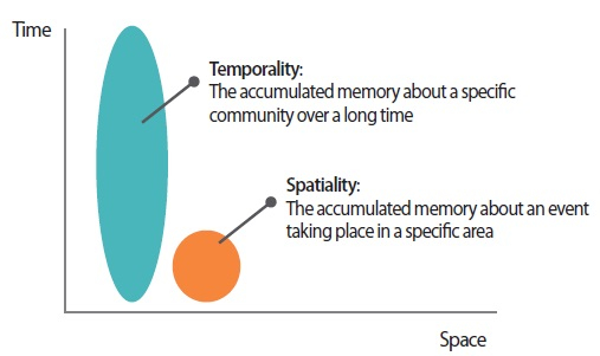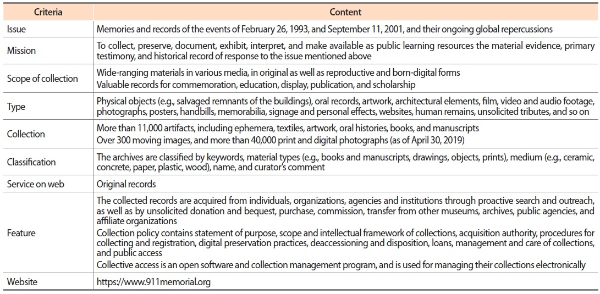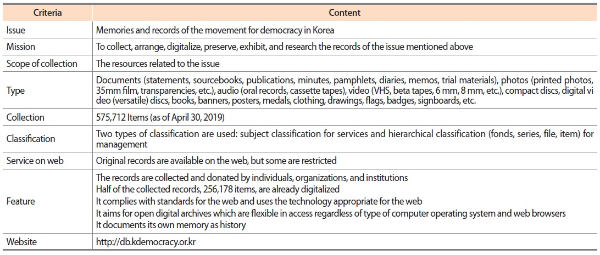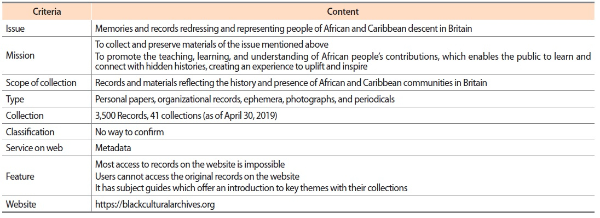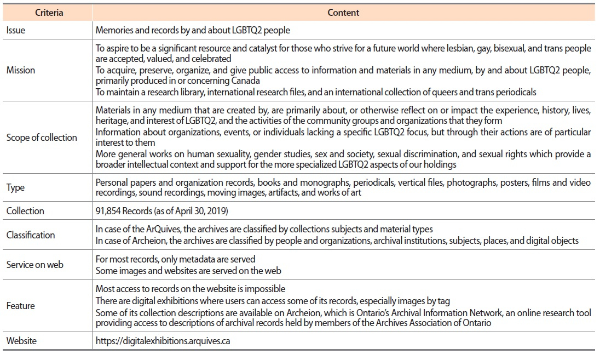ISSN : 2287-9099
How Can We Preserve Social Memories?: Exploration of Global Open Archives

Geon Kim (Graduate School of Archives and Records Management, Jeonbuk National University)

Hyo-Jung Oh (Department of Library and Information Science, Jeonbuk National University)

Abstract
Until now, records re-enacting social memories have not been main targets for preservation and management in Korea. However, people have recently begun to focus on forming and maintaining their memories because these personalized records have started to be recognized as social and political issues. In this respect, this study aims to find out how to preserve social memories by comparing various global open archives. For achieving our research goal, we first established the definition of social memories and records and revealed their characteristics. After then, we selected representative open archives’ websites to examine their collection polices and compare them according to several criteria. As a result, we distilled insights based on similarities and differences of each archive and discussed considerations in preserving social memories consisting of three phases: analyzing target social memories, establishing collection policies, and collecting actual records. This study has significance in that it examines the characteristics of social memories and records and also suggests preliminary findings for advanced research to develop practical tools for social records management and archives.
- keywords
- social memory, social records, open archives, social records archives
1. INTRODUCTION
Since the 2000s, there has been much research discussing memory in the social sciences. This was based on postmodernism, in which the study of history denied objectivity and the scientific characteristics of history and focused on ‘small things’ and ‘culture’ (Youn, 2011). With this academic trend, the memories which have been recognized in terms of personal mentality until now start to be perceived as social and political issues. This is when people began to focus on forming and maintaining their memories. Accordingly, the academic paradigm of records and archives management also moved to management for records capturing normal people’s small things and lives, called ‘collective memory’ or ‘social memory,’ which have been excluded from the mainstream for a long time.
Until now, records re-enacting social memory have not been main targets for preservation and management in Korea. Even though the Public Records Act in 1999 mentioned that both the records created mainly by officials (public records) and the records describing people’s normal lives (social records) should be managed for long term preservation, standardized management methods were proposed and implemented only for public records. Such a focus on public records makes social records scattered or non-existent, and it makes reappearance of social memories by records difficult. For instance, we cannot understand clearly the events such as the Korean War and the movement in the 1980s for democracy in Korea, because there were few records containing perspectives and understandings of normal people, including laborers and women at that time. The only managed records, public records, cannot cover such various perspectives and understandings, and we can barely understand the past in view. Therefore, to document and preserve such social memories, it is necessary to understand what social memory and social records are and seek methods for collecting, managing, and preserving them.
In this situation, our study explores local and foreign archives to suggest meaningful insights and strategies for preserving social memories and managing social records. For achieving this research goal, we select representative open archives which collect, manage, and preserve social records created from events having a huge influence on many people’s lives in the world or created by communities sharing thoughts and experiences. Their websites and collection policies are examined according to several criteria, and insights based on similarities and differences of each archive are extracted. Finally, considerations in preserving social memories are indicated, and guidelines for managing social records are proposed.
2. SOCIAL MEMORIES AND SOCIAL RECORDS
2.1. What Social Memories Are: Review of Related Research
A concept of collective memory was proposed for the first time in 1950 by Maurice Halbwaches in his book The collective memory. According to Halbwaches and Coser (1992), Halbwaches stated in the book that collective memory is not a given but rather a socially constructed notion, and there are as many collective memories as there are groups and institutions in a society. In addition, he argued that every collective memory requires the support of a group delimited in space and time. With the notion of collective memory, he distinguished it into two types: historical memory and autobiographical memory. The first means memory of events that people can experience only through written records and other types of records, so that, in that case, people do not remember events directly and the past is stored and interpreted by social institution. On the other hand, the latter means memories of events that people have personally experienced in the past, so the memory tends to melt away with time if it is not periodically strengthened through contact with people sharing the same experience in the past.
When it comes to memory, Jimerson (2003) defines memory in his article Archives and memory as what may be contained in archives and manuscripts, preserved because of their value as fixed and unchanging sources for corroborating or challenging personal memory. In the same article, Jimerson also notes that such artifacts and documents provide the most reliable evidence available for understanding the past, although they are merely surrogates for memory. In this point of view, he explains four types of memory, including collective memory, and about how collective memory contributes to shaping the self-identity of social groups.
Similar to Jimerson, Youn (2016) and Shinn (2016) try to understand collective memory in terms of identity. According to their research, people can understand themselves by reorganizing and closely examining their experiences in a cultural system, not just by going through experiences. “A cultural system” is formed by memory, for instance, community memory in a society where individuals live together with other people of diverse backgrounds, and where their experiences and memories of the experience are accumulated as custom. People add a new meaning to their experience and memory in the cultural system formed before, which lets them “identify” themselves. In other words, memories in a social context are related to the identity of the community or individuals.
In addition to the research reviewed above, there have been many studies discussing collective memory for the past few decades in many academic fields. The different paradigms in the field of collective memory studies were summarized by de Saint-Laurent (2018)’s study, Memory acts: A theory for the study of collective memory in everyday life. de Saint-Laurent examined the studies related to collective memory and proposed ‘the memory act’ as a new conceptualization of collective memory.
As the studies mention above, most of the related studies use the term ‘collective memory’ as meaning a community’s memory. However, it is difficult for the term to embrace a concept of memories of people who are not in the same community but share same memory constructed by an event influencing many people. Thus, we choose the term ‘social memory’ in this study because it can encompass a wide range of concepts of both the memory of a community and memory about events. Social memories can be defined as the memory constructed by, describing, and re-enacting events which have a huge impact on contemporary society, and as the memory of communities where people share their interests, perspectives, opinions, sorrow, and happiness with fellowship in adjacent geographical areas.
2.2. Types and Characteristics of Social Memory
In this section, we establish the definition of social memories and records based on the review of related research, and then we refine their characteristics. This study tries to classify social memory by what it is about, that is, by the issues it deals with. It also attempts to explain characteristics of social memories by space and time, which are two of three elements that contribute to formation of social memory.
By the issue memory describes, social memory can be divided into two types: events memory and community memory. First, events memory is social memory about events which have a huge influence on contemporary society. Thus, it contains diverse opinions and perspectives of people from various backgrounds who experience the events. Events in the memory can happen naturally and/or socially. Natural events mostly include disasters such as earthquakes and typhoons, while social ones have many sudden casualties, like wars or huge accidents. On the other hand, community memory is social memory about people who have already had relationships with friends, relatives, neighbors, and so on. They usually live in geographically adjacent areas and share the same interests regardless of their position, sex, and age. Community memory can be separated into two types depending on what a community’s base is. One type is the community where people live closely to each other and share similar perspectives formed in their living area, so it is mainly based on location. The other is the minority community, where people have a sense of kinship because they all suffer from political or financial oppression, like women and people of color (Table 1).
With relevance to communities, space and time are important elements which help to form social memories. Space is a symbol of giving testimony about some crisis or the opposition to the crisis which a community experienced, and it plays a role of a prop to rediscover the identity of the community. On the other hand, time means social time when an event happened, such as an anniversary day, and it helps social memory to be realized in a person’s consciousness (Kim, 2014; Choi, 2003).
In this regard, social memory can be explained by ‘temporality’ and ‘spatiality.’ It means that of time and space, which are valuable elements when memory is constructed from an event or a community. Thus, the memory which has temporality is usually constructed based on the continuity of an event or a community, while the memory which has spatiality is usually constructed based on location of an event or a community. In particular, the former is an essential characteristic of accumulated memory about a specific community which stays for a long time, and the latter is an essential characteristic of accumulated memory about an event which take place in a specific area. That is why temporality appears mainly in community memory, whereas spatiality does mainly appear in event memory. However, social memories can usually have one or both of them (Fig. 1).
2.3. Social Records
Previous research focused on defining what general records are in terms of characteristics, form, and structure of records, but there were few attempts of defining ‘social’ records. This study aims to define social records by reviewing a few definitions of records, including the definitions of International Standard Organization (ISO) and Society of American Archivists1 (SAA), which have typically been used.
According to ISO 15489-1:2016 (2016), establishing the core concepts and principles for the creation, capture, and management of records, a record(s) is defined as information created, received, and maintained as evidence and as an asset by an organization or person, in pursuit of legal obligations or in the transaction of business. As what documents individual events or transactions, records should possess the characteristics of authenticity, reliability, integrity and usability to be considered authoritative evidence of business events or transactions to fully meet the requirements of the business. It seems that the definition of ISO focuses mainly on public records which should be managed and preserved for accountability of government business and functions, so it is hard to understand what social records are only by its definition.
On the other hand, SAA give seven definitions of records in a glossary of archival and records terminology (accessed May 9, 2019). Among them, definition numbers two and three explain records in terms of its content unlike other definitions in regard to the medium of records such as document and audio. It noted that a record(s) is data or information that has been fixed on some medium; that has content, context, and structure; and that is used as an extension of human memory or to demonstrate accountability and data or information in a fixed form that is created or received in the course of individual or institutional activity and set aside (preserved) as evidence of that activity for future reference. Through the definitions, it is indicated that SAA explains records as a comprehensive term by mentioning human memory, in contrast to ISO’s definition.
Finally, the Korean Society of Archival Studies (2008) defines records as documents which are created by or ingested in individuals’ or organizations’ activities or work processes, and they have content, structure, and context. It stated that, among three elements of records, content is the most important conceptual element and extension of memory which can be remembered repeatedly over time. Thus, in wide scope, records can include things, regardless of media, which expand a person’s memory and meet accountability. It seems that its definition was based on SAA’s definition because the definition also mentioned memory as human activity and considered it as what is preserved for future generations.
To summarize, records are things fixed on a medium, regardless of medium types, which capture and describe human activity with content, structure, and context as proofs. As well, social records can be defined as things fixed on some medium, regardless of media types, which capture and describe social memories, a kind of human activity. They inherit all characteristics of general records and social memory, so it is necessary for the characteristics to be considered in preserving social memories. In this regard, this study explored global open archives for social memory and social records. Based on comparison, we figure out how the archives preserve and reenact their memories.
3. THE EXPLORATION OF SOCIAL MEMORIES ARCHIVES
For extracting meaningful strategies to preserve social memories and manage social records, we selected six representative global open archives: Japan Disasters Digital Archive2 (JDA), National September 11 Memorial and Museum (9/11 archives), Open Archives3, United States Holocaust Memorial Museum4, Black Cultural Archives5, and ArQuives6. The archives were selected for three reasons as follows. First, they are trustworthy since they were already mentioned as cases of archives for social memory in other studies (Youn, 2012; Jung, 2016; Han, Gang, Kim, & Oh, 2017; Jung & Lee, 2018). Second, the memories the archives try to preserve are influential events in the world or about well-known communities, so it is easy to show and explain the types and the characteristics of social memories and social records, which are described in Section 2. Last, the archives are useful to determine consideration in preserving social memories because they have well-organized records management systems, particularly in terms of access on the web.
In exploration of the archives, we compared their web services and collection policies according to several criteria. A collection policy written based on an institution’s vision and mission is an important resource for precise examination in that it shows what the institution wants to memorize and preserve and is also grounds for selecting records they collect or not. The criteria were extracted from their collection policies and related studies mentioned above. The criteria are usually included in a collection policy and show the capability and possibility of archives to manage and preserve memory and records. The criteria used for the investigation are missions of the archives, scope of collection, types of records, size of collection, way of service, and so on.
The rest of this section is divided into two sub-sections by types of social memory, events memory and community. Based on the archives’ vision and mission, the issues that memory describes are determined. Thus, for legibility and understanding, results of exploring the archives are organized by types of social memory.
3.1. Events Memory
3.1.1. JDA
The JDA started with the project controlled by Harvard University and collects memories and records of the earthquake which occurred March 11, 2011 in Japan. JDA especially collects electronic resources about personal experiences of the disasters and their aftermath such as websites, tweets, news articles, and so on. JDA is composed of 461 collections and the items are served as original records and links. JDA is a collaborative space for citizens, researchers, students, and policy makers, and is a site of shared memory for those most directly affected by these events. Unfortunately, its collection policy was not found, but information for the analysis can be found on the website (Table 2).
3.1.2. 9/11 archives
The 9/11 archives collects memories and records of the horrific attacks of September 11, 2001 and the terrorist events of February 26, 1993. Its collections contain materials in various media, in original as well as reproductive and borndigital forms, and valuable records for education, publication, and so on. Types of records are varied such as physical objects, oral records, film, video, etc. According to its collection policy (National September 11 Memorial and Museum, 2013), 9/11 archives try to collect websites, human remains, and unsolicited tributes, but the types cannot be found on the 9/11 archives website. Its permanent collections have more than 11,000 items and include over 300 moving images and more than 40,000 print and digital photographs. Finally, the 9/11 archives have a collection policy and manage the collected records by a records management process (Table 3).
3.1.3. Open Archives
Open Archives, which is operated by the Korea Democracy Foundation, was established to collect, arrange, digitalize, preserve, exhibit, and research the records of the movement for democracy in Korea. Open Archives holds 575,712 records including documents, audio, video, books, diverse objects, and so on, and the collections are grouped by events, times, and such material types. Due to the three types of classification, users can select how they want to see them and re-organize the records in their own perspectives. The records are served as original records for service, but some are restricted in use (Table 4).
3.2. Community Memory
3.2.1. United States Holocaust Memorial Museum
The United States Holocaust Memorial Museum is a repository which documents Holocaust memories of people such as victims, survivors, rescuers, liberators, and others and aims to create a “permanent living memorial to the victims of the Holocaust” (United States Holocaust Memorial Museum, 2018). Thus, the United States Holocaust Memorial Museum collect records that relate to their stories, experiences, and histories and the collections are composed of 275,724 records such as documents, artifacts, photos, films, books, and testimonies. The records are provided as original records except for oral history (Table 5).
3.2.2. Black Cultural Archives
The Black Cultural Archives is the only national institution dedicated to collecting, preserving, and celebrating the histories of the diverse people of African and Caribbean descent in Britain. The Black Cultural Archives collect records reflecting the history and presences of African and Caribbean communities in Britain such as personal papers, ephemera, and photos. The records are 3,500 items and grouped by 41 collections. However, users can not access the original records, and even digitalized records on the website are closed (Table 6).
3.2.3. The ArQuives
The ArQuives was established to recover and preserve lesbian, gay, bisexual, transgender, queer, and questioning (LGBTQ2) peoples’ history. Thus, it tries to acquire, preserve, organize, and give public access to information and materials in any form, by and about the community. The ArQuives has an acquisition policy by which it decides what kinds of material to gather, preserve, and make available (CLGA Operations Committee, 2016) (Table 7).
4. INSIGHTS
4.1. Comparison of the Archives for Social Memories
As a result of exploring the archives for social memories, similarities and differences of the archives are determined. The six representative archives are compared in terms of issue, type and characteristic of social memory, way of collection, service on the web, and records provenance after they are categorized by the issues of the archives.
As shown in Table 8, the six archives are different in every condition. They all deal with different memories and serve their records in different ways. For service, most of them provide their records on the web with original records, but the Black Cultural Archives provide online only metadata without original records. In addition, most of the archives collect the records manually through acquisition and donation, but some of the records are collected automatically using web crawlers in the cases of JDA and 9/11 archives.
Table 8.
Comparison of the archives for social memory
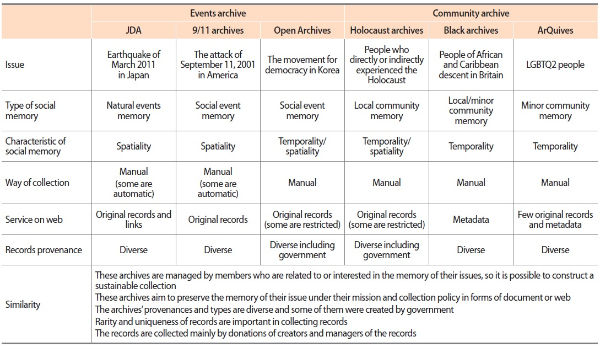
JDA, Japan Disasters Digital Archive; 9/11 archives, National September 11 Memorial and Museum; Holocaust archives, United States Holocaust Memorial Museum; Black archives, Black Cultural Archives; LGBTQ2, lesbian, gay, bisexual, transgender, queer, and questioning.
However, it is explicit that all the archives try to preserve the memory of their issue under the institution’s mission and collection policy. Furthermore, the members of these archives are comprised of people who are related to the memory of their issue and who can be considered as experts on their issue and records management, so it is possible to select relevant records based on evidential value, cultural value, and historical value.
The result of this comparison shows that many archives, especially one for social memory and records, are no longer closed and exclusive. As mentioned above, most of the open archives collected serve the records via the Internet for free. Thus, everyone who wants to use and see a record or who wants to share their records with others can do that. Records are no longer exclusive properties for people who have political or religious power. The result also indicates that archives do not need a massive room to keep records any more. Despite serving digital records on the web, most of the archives still need a big room to keep the original records and storage for digitalized files. However, as shown in the case of JDA which collects, preserves, and serves links of most of the digital records, it is important to provide seamless links to digital materials collected or archived by people who want to share their records and memory. Rather, how to connect memory with records will be more important.
4.2. Consideration in Preserving Social Memories
In this section, phases to build archives for social records are proposed as a way of preserving social memories. We distilled insights based on similarities and differences of each archive and discussed considerations in preserving social memories, consisting of three phases: analyzing target social memories, establishing collection policies, and actually collecting records.
4.2.1. Analyzing Target Social Memories
The first phase of preserving social memories is the analysis of target social memories in terms of types and characteristics. The task is to determine and select the context of records in creation. In managing records, according to ISO 15489-1:2016 (2016), context information should be obtained as metadata because records without such information can lack the characteristics of authoritative records. Metadata depicts business context, dependencies and relationships among records and records systems, relationships to legal and social context, and relationships to agents who create, manage, and use records. Therefore, it is useful to identify, describe, understand, and manage records. Metadata is defined by metadata schema which support the creation of point of capture metadata and process metadata. With respect to metadata schema, KS X ISO TS 23081-2:2008 (2008), a standard of metadata in Korea, which was translated from an international standard of metadata, indicated five entities: records, agents, business (or function), mandates, and relationships.
The analysis of types of social memories aims to clarify targets for preservation and to get the context information of the target. For example, the memory type of the Korea Democracy Foundation’s Open Archives is events memory because Open Archives tries to preserve the memory of the movement for democracy in Korea. Thus, it needs to get the context information about the movement for democracy as metadata. The metadata schema of Open Archives in trying to preserve events memory can be organized based on the business entity since the entity explains activities, functions, and transactions depicted in records. This way, the analysis of types of social memories helps archives to select construction of metadata schema based on entities. In general, the metadata of the business entity, in case of events memory, and the metadata of the agents entity, in case of community memory, can be acquired more easily and precisely than without the analysis.
In addition, the analysis of characteristics of social memories aims to predict location, provenance, and types of social records. Such information of social records can be used as metadata and helps the establishment of a collection policy, the second phase, because it implies where social records can be, who can create and possess related records and information, and what types of social records exist.
4.2.2. Establishing a Collection Policy
After the analysis of social memories in terms of types and characteristics are conducted, a collection policy should be established. Social records can be collected in a variety of channels because they have been scattered for a long time, so they are different in possessors, creators, materials, types, and so on. Thus, criteria for organized collection of such records are necessary.
Prior to establishment of a collection policy, the thing to be considered is a committee for operating the archives. Committees handle all of the things required for operation of the archives, so it should be composed of members 1) who are experts on the issue which the archives deal with, 2) who are experts on records management to design the process for management of the records, and 3) who are related to or are interested in the issue for sustainable management of the archives. The composition can keep a balance between tasks for records management in preserving social memories.
The criteria for a collection policy can include the issues archives deal with, mission and vision of the archives, scope of collection, types of records to be collected, classification system, and ways to serve. Of the criteria, the issue and the mission and vision mean that the archives decide what to collect or not, and the decision for the archives’ collection scope based on them helps to outline its operation. Determining the scope of collection and types of records needs to be based on the capability of the archives. There can be many diverse types and materials of social records such as paper records, oral records on tapes or compact discs, films of 35 mm or transparencies, etc. However, it is not guaranteed that all archives are able to manage and preserve these types of records because they cannot have the experts or persons who have deep knowledge of special media or the facilities to keep the records in appropriate condition. Therefore, it is necessary to consider the capability of the archives as to human and financial resources for the scope of collection and types of records. Finally, classification systems and service ways are allowed for users’ convenience. In particular, classification for records management should have at least two designs including the classification for service, like one based on topics to help users to easily find records, and hierarchical classification based on the state of record aggregation. Since social records have a variety of provenance, creators, and materials as mentioned before, there are also diverse needs of users in retrieval. Thus, it is required to classify the records based on users’ needs or to construct collections by characteristics of them.
Besides these criteria, it is asked that the issues of copyright, ownership, and metadata are considered in establishing a collection policy. In case of metadata, archives committees can refer to international standards for metadata like ISO 23081 or Dublin Core to be compatible with other archives’ metadata schema.
4.2.3. Collecting Records
With a collection policy established, collecting records in practice is planned and implemented. The important things in this phase are the focus on electronic records which can be born-digital records or digitalized records and the strategies to collect and manage the records.
Records have been generally collected by donation, transfer, direct collection by staff of the archives, and other ways. However, a recent tendency shows that the amount of electronic records, which increase with the development of information techniques, requires the archives to prepare for collecting the electronic records. As a case reflecting the trend, the 9/11 archives, one of the archives in Section 3, already try to collect electronic records using web crawlers as a collection strategy for those scattered on the web. Moreover, JDA, also mentioned in Section 3, even collects links which point out where original records are, not the original records themselves. Such a strategy helps to reduce financial burden to manage the storage used for preserving an amount of electronic records. It also helps archives to easily collect a number of records and metadata to process them quickly in records management systems.
In collecting records, there can be many consideration factors in terms of financial, human, and materials resources. Therefore, when the archive makes specific plans for its operation, it has to reflect its collection policy with the focus on the capture and the ingestion of electronic records step by step. The strategies should include solutions for problems which archives can face as they process electronic records.
5. CONCLUSION
People constantly create, edit, reinforce, test, and recount their own memories of events in their lives (Jimerson, 2003). In this sense, it is necessary to collect and preserve the records describing such memories for providing the whole of our society, not a single side of our society, for future generations. Thus, this study aims to propose significant insights and strategies in preserving social memories and managing social records by exploring several representative global open archives.
Before the exploration, we established the definition of social memories and records and refined their characteristics by reviewing previous related studies. After, we then selected six representative open archives and compared their websites and collection polices according to several criteria. The criteria were as such: issues they deal with, their mission and vision, scope of collection, classification, service on the web, and so on.
As a result, we proposed insights based on the similarities and differences of the archives and described considerations in preserving social memories, consisting of three phases: analyzing target social memories, establishing a collection policy, and actually collecting records. First, archives for social memories analyze the types and characteristics of target social memory to determine the context information in creating records. Second, the archives establish a collection policy including criteria like scope of collection with the committee organized. Finally, the archives collect records in practice with a focus on electronic records and strategies to collect and manage the records.
This study has significance in that it determined definition, types, and characteristics of social memory and social records and in that it suggested preliminary findings for advanced research to design tools for social memories records management and service.
References
Acquisitions policy (1.0). (CLGA Operations Committee) ((2016), Retrieved June 2, 2019) CLGA Operations Committee. (2016). Acquisitions policy (1.0). Retrieved June 2, 2019 from https://arquives.ca/wpcontent/uploads/2017/02/Acquisitions-Policy-V.01.pdf. , from https://arquives.ca/wpcontent/uploads/2017/02/Acquisitions-Policy-V.01.pdf
ISO 15489-1:2016. Information and documentation—Records management—Part 1: Concepts and principles (ISO) ((2016), Retrieved June 2, 2019) ISO. (2016). ISO 15489-1:2016. Information and documentation—Records management—Part 1: Concepts and principles. Retrieved June 2, 2019 from https://www.iso.org/standard/62542.html. , from https://www.iso.org/standard/62542.html
A study of acquisition for disaster collections on The National September 11 Memorial & Museum.((2016)) Seoul: Graduate School of Myongji University Jung, H.-J. (2016). A study of acquisition for disaster collections on The National September 11 Memorial & Museum. (master’s thesis). Graduate School of Myongji University, Seoul. , JungH.-J., master’s thesis
KS X ISO TS 23081-2:2008. Information and documentation—Records management processes—Metadata for records—Part 2: Conceptual and implementation issues. (Korea Industry Standards Committee) ((2018)) Seoul: Korea Industry Standards Committee Korea Industry Standards Committee. (2018). KS X ISO TS 23081-2:2008. Information and documentation—Records management processes—Metadata for records—Part 2: Conceptual and implementation issues. Seoul: Korea Industry Standards Committee.
2013 Collection management policy. (National September 11 Memorial and Museum) ((2013), Retrieved June 2, 2019) National September 11 Memorial and Museum. (2013). 2013 Collection management policy. Retrieved June 2, 2019 from https://www.911memorial.org/sites/default/files/2013_CollectionsPolicy%20.pdf. , from https://www.911memorial.org/sites/default/files/2013_CollectionsPolicy%20.pdf
, Sinn, D.-H. (2016). , Personal records and regional records in paradigm of memory, . Paper presented at the 2016 Spring Conference of Records Management & Archives Society of Korea and the Korean Biblio Society for Library and Information Science, Seoul, Korea., , Personal records and regional records in paradigm of memory., Paper presented at the 2016 Spring Conference of Records Management & Archives Society of Korea and the Korean Biblio Society for Library and Information Science, (2016), Seoul, Korea
Scope and nature of the collections. (United States Holocaust Memorial Museum) ((2018), Retrieved June 2, 2019) United States Holocaust Memorial Museum. (2018). Scope and nature of the collections. Retrieved June 2, 2019 from https://www.ushmm.org/collections/the-museumscollections/about/scope-and-nature-of-the-collections. , from https://www.ushmm.org/collections/the-museumscollections/about/scope-and-nature-of-the-collections
- Submission Date
- 2019-06-04
- Revised Date
- Accepted Date
- 2019-09-06
- 489Downloaded
- 1,170Viewed
- 0KCI Citations
- 0WOS Citations



